Grain-Size Distribution of Surface Sediments in the Chanthaburi Coast, Thailand and Implications for the Sedimentary Dynamic Environment
Abstract
:1. Introduction
2. Materials and Methods
2.1. Sediment Sampling
2.2. Sediment Grain Size Measurements
2.3. Grain-Size Transport Trend Analysis
3. Results
3.1. Sediment Distribution Characteristics
3.2. Planar Distribution Characteristics of Sedimentary Grain Groups
3.3. Analysis of Sediment Grain-Size Characteristics
3.4. Sensitive Grain-Size Component
3.5. Surface Sedimentary Dynamic Division
3.6. Sediment Grain-Size Trend Analysis
4. Discussion
4.1. Division of Sedimentary Environments and Preliminary Analysis of Sediment Provenance
4.2. Comparison with Tidal-Controlled Estuaries in the Temperate Region of Eastern China
5. Conclusions
Author Contributions
Funding
Acknowledgments
Conflicts of Interest
References
- Shi, X.; Liu, S.; Fang, X.; Qiao, S.; Khokiattiwong, S.; Kornkanitnan, N. Distribution of clay minerals in surface sediments of the western Gulf of Thailand: Sources and transport patterns. J. Asian Earth Sci. 2015, 105, 390–398. [Google Scholar] [CrossRef]
- Buranapratheprat, A.; Luadnakrob, P.; Yanagi, T.; Morimoto, A.; Qiao, F. The modification of water column conditions in the Gulf of Thailand by the influences of the South China Sea and monsoonal winds. Cont. Shelf Res. 2016, 118, 100–110. [Google Scholar] [CrossRef]
- Liu, S.; Shi, X.; Yang, G.; Khokiattiwong, S.; Kornkanitnan, N. Distribution of major and trace elements in surface sediments of the western Gulf of Thailand: Implications to modern sedimentation. Cont. Shelf Res. 2016, 117, 81–91. [Google Scholar] [CrossRef]
- Zhang, X.; Ji, Y.; Yang, Z.; Wang, Z.; Liu, N.; Jia, P. End member inversion of surface sediment grain size in the South Yellow Sea and its implications for dynamic sedimentary environments. Sci. China Earth Sci. 2015, 59, 258–267. [Google Scholar] [CrossRef]
- Juez, C.; Hassan, M.A.; Franca, M. The Origin of Fine Sediment Determines the Observations of Suspended Sediment Fluxes Under Unsteady Flow Conditions. Water Resour. Res. 2018, 54, 5654–5669. [Google Scholar] [CrossRef]
- Boulay, S.; Colin, C.; Trentesaux, A.; Pluquet, F.; Bertaux, J.; Blamart, T.; Buehring, C.; Wang, P. Mineralogy and Sedimentology of Pleistocene Sediment in the South China Sea (ODP Site 1144). Proc. ODP Sci. Result. 2003, 184, 1–21. [Google Scholar]
- Huang, J.; Li, A.; Wan, S. Sensitive grain-size records of Holocene East Asian summer monsoon in sediments of northern South China Sea slope. Quat. Res. 2011, 75, 734–744. [Google Scholar] [CrossRef]
- Chen, G.; Zheng, H.; Li, J.; Xie, X.; Mei, X. Dynamic control on grain-size distribution of terrigenous sediments in the western South China Sea: Implication for East Asian monsoon evolution. Sci. Bull. 2008, 53, 1533–1543. [Google Scholar] [CrossRef] [Green Version]
- Weltje, G.J. End-member modeling of compositional data: Numerical-statistical algorithms for solving the explicit mixing problem. Math. Geol. 1997, 29, 503–549. [Google Scholar] [CrossRef]
- Dietze, E.; Hartmann, K.; Diekmann, B.; Ijmker, J.; Lehmkuhl, F.; Opitz, S.; Stauch, G.; Wünnemann, B.; Borchers, A. An end-member algorithm for deciphering modern detrital processes from lake sediments of Lake Donggi Cona, NE Tibetan Plateau, China. Sediment. Geol. 2012, 243, 169–180. [Google Scholar] [CrossRef]
- McLaren, D.B.P. The Effects of Sediment Transport on Grain-Size Distributions. J. Sediment. Res. 1985, 4, 457–470. [Google Scholar]
- McLaren, P.; Hill, S.; Bowles, D. Deriving transport pathways in a sediment trend analysis (STA). Sediment. Geol. 2007, 202, 489–498. [Google Scholar] [CrossRef]
- Gao, S.; Collins, M.; Lanckneus, J.; De Moor, G.; Van Lancker, V. Grain size trends associated with net sediment transport patterns: An example from the Belgian continental shelf. Mar. Geol. 1994, 121, 171–185. [Google Scholar] [CrossRef]
- Gao, S. A FORTRAN program for grain-size trend analysis to define net sediment transport pathways. Comput. Geosci. 1996, 22, 449–452. [Google Scholar] [CrossRef]
- Barbera, G.; Feo, R.; Freni, G. Sediment transport modelling based on grain size trend analysis in Augusta Harbour (Sicily). In Proceedings of the International Conference of Computational Methods in Sciences and Engineering 2015 (Iccmse 2015); AIP Publishing: Athens, Greece, 2015; Volume 1702, p. 180008. [Google Scholar]
- Su, Q.; Peng, C.; Yi, L.; Huang, H.; Liu, Y.; Xu, X.; Chen, G.; Yu, H. An improved method of sediment grain size trend analysis in the Xiaoqinghe Estuary, southwestern Laizhou Bay, China. Environ. Earth Sci. 2016, 75. [Google Scholar] [CrossRef]
- Li, T.; Li, T.J. Sediment transport processes in the Pearl River Estuary as revealed by grain-size end-member modeling and sediment trend analysis. Geo-Mar. Lett. 2017, 38, 167–178. [Google Scholar] [CrossRef]
- Buranapratheprat, A.; Bunpapong, M. A Two-Dimensional Hydrodynamic Model for the Gulf of Thailand. Ioc/westpac Fourth Int. Sci. Symp. 1998, 469, 478. [Google Scholar]
- Udden, J.A. Mechanical composition of clastic sediments. GSA Bull. 1914, 25, 655–744. [Google Scholar] [CrossRef]
- Folk, R.L.; Ward, W.C. Brazos River bar: A study in the significance of grain size parameters. J. Sediment. Res. 1957, 27, 3–26. [Google Scholar] [CrossRef]
- Lin, Y.; Li, Y.; Zheng, B.; Yin, X.; Wang, L.; He, J.; Shu, F.; Qiao, L. Evolution of sedimentary organic matter in a small river estuary after the typhoon process: A case study of Quanzhou Bay. Sci. Total. Environ. 2019, 686, 290–300. [Google Scholar] [CrossRef]
- Gao, S.; Collins, M. Net sediment transport patterns inferred from grain-size trends based upon definition of Btransport vectors. Sediment. Geol. 1992, 80, 47–60. [Google Scholar] [CrossRef]
- Cheng, P.; Gao, S.; Bokuniewicz, H. Net sediment transport patterns over the Bohai Strait based on grain size trend analysis. Estuarine Coast. Shelf Sci. 2004, 60, 203–212. [Google Scholar] [CrossRef]
- Gao, S. The use of grain size trends in marine sediment dynamics (in Chinese). China Sci. Found. 1998, 12, 241–246. [Google Scholar]
- Le Roux, J. Net sediment transport patterns inferred from grain-size trends, based upon definition of “transport vectors”—Comment. Sediment. Geol. 1994, 90, 153–156. [Google Scholar] [CrossRef]
- Ríos, F.; Cisternas, M.; Correa, I.; Le Roux, J. Seasonal sediment transport pathways in Lirquen Harbor, Chile, as inferred from grain-size trends. Investig. Mar. 2002, 30. [Google Scholar] [CrossRef] [Green Version]
- Shepard, F.P. Nomenclature Based on Sand-silt-clay Ratios. J. Sediment. Res. 1954, 24, 151–158. [Google Scholar]
- Doeglas, D.J. Grain-size indices, classification and environment. Sedimentology 1968, 10, 83–100. [Google Scholar] [CrossRef]
- Ze-wen, L.; Zhen-dong, L.; Jun, Y.; Li-hua, Z. Characterization of grain size parameters and the provenance analysis of the surface sediment in the outer shelf of the northern South China Sea (in Chinese). Mar. Sci. 2011, 35, 92–100. [Google Scholar]
- Flemming, B. A revised textural classification of gravel-free muddy sediments on the basis of ternary diagrams. Cont. Shelf Res. 2000, 20, 1125–1137. [Google Scholar] [CrossRef]
- Liu, J.; Saito, Y.; Kong, X.; Wang, H.; Xiang, L.; Wen, C.; Nakashima, R. Sedimentary record of environmental evolution off the Yangtze River estuary, East China Sea, during the last ∼13,000 years, with special reference to the influence of the Yellow River on the Yangtze River delta during the last 600 years. Quat. Sci. Rev. 2010, 29, 2424–2438. [Google Scholar] [CrossRef]
- Tian, Y.; Fang, J.; Zhang, X.; Chen, B.; Wang, L.; Pang, Y. Sensitive grain size components and their geological implication in the inner shelf of the East China Sea (in Chinese). Oceanol. Limnol. Sin. 2016, 47, 319–326. [Google Scholar]
- Chen, M.; Qi, H.; Wichen, I.; Apichai, K.; Wang, C.; Zhang, A. Distributions of diatoms in surface sediments from the Chanthaburicoast, Gulf of Thailand, and correlations with environmental factors. Reg. Stud. Mar. Sci. 2020, 34, 2352–4855. [Google Scholar]
- Committee, C.G.C. China Gulf Records (in Chinese); Ocean Press: Beijing, China, 1998. [Google Scholar]
- Zordan, J.; Juez, C.; Schleiss, A.J.; Franca, M. Entrainment, transport and deposition of sediment by saline gravity currents. Adv. Water Resour. 2018, 115, 17–32. [Google Scholar] [CrossRef]
- Ding, Y.; Sikka, D.R. Synoptic Systems and Weather; Springer: Berlin/Heidelberg, Germany, 2006; pp. 131–201. [Google Scholar]
- Tang, L.; Sheng, J.; Ji, X.; Cao, W.; Liu, D. Investigation of three-dimensional circulation and hydrography over the Pearl River Estuary of China using a nested-grid coastal circulation model. Ocean Dyn. 2009, 59, 899–919. [Google Scholar] [CrossRef]
- Zheng, J.; Li, M.; Mai, M. Hydrographic and sediment analyses of the Oujiang estuary (in Chinese). J. Waterw. Harbor 2008, 29, 1–7. [Google Scholar]
- Xu, T.; You, X.-Y. Numerical simulation of suspended sediment concentration by 3D coupled wave-current model in the Oujiang River Estuary, China. Cont. Shelf Res. 2017, 137, 13–24. [Google Scholar] [CrossRef]
- Shao, H. Analysis of Sand Volume and Its Change in Three Major Rivers in Fujian (in Chinese). Fujian Soil Water Conserv. 1991, 1, 42–46. [Google Scholar]
- Jiang, W. On water level change of the south channel in the estuary of Jiulongjiang River (in Chinese). J. Subtrop. Resour. Environ. 2008, 3, 57–61. [Google Scholar]
- Zhao, H. Hydrological and Sediment Characteristics of the Pearl River Estuary (in Chinese). Trop. Geogr. 1989, 3, 201–212. [Google Scholar]
- Wong, L.A.; Heinke, G.; Chen, J.C.; Xue, H.; Dong, L.X.; Su, J.L. A model study of the circulation in the Pearl River Estuary (PRE) and its adjacent coastal waters: 1. Simulations and comparison with observations. J. Geophys. Res. Space Phys. 2003, 108. [Google Scholar] [CrossRef]
- Mao, Q.; Shi, P.; Yin, K.; Gan, J.; Qi, Y. Tides and tidal currents in the Pearl River Estuary. Cont. Shelf Res. 2004, 24, 1797–1808. [Google Scholar] [CrossRef]
- Yang, X. Clay minerals of suspended sediments in Oujiang River (in Chinese). Mar. Sci. Bull. 1995, 14, 86–92. [Google Scholar]
- Fang, J.; Chen, J.; Wang, A.; Li, D.; Huang, C. The modern sedimentary environment and transport trends in Jiulongjiang estuary (in Chinese). Mar. Geol. Quat. Geol. 2010, 2, 35–41. [Google Scholar] [CrossRef]
- Xu, T.; Mai, M.; Han, Z. Analysis of Hydrodynamic and Sediment Environment in the Oujiang River Estuary (in Chinese). Water Resour. Sci. Technol. 2018, 24, 5–9. [Google Scholar]
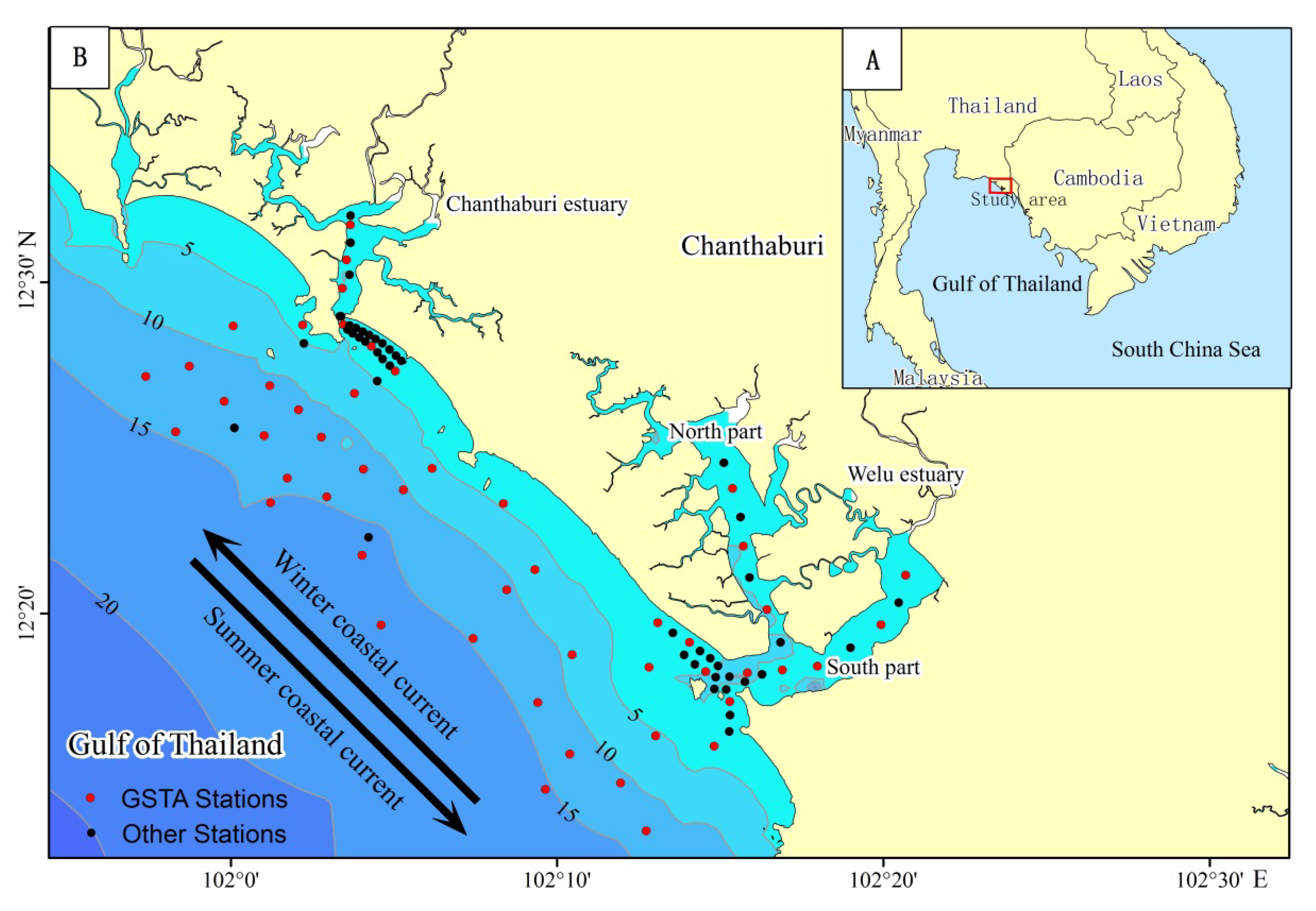
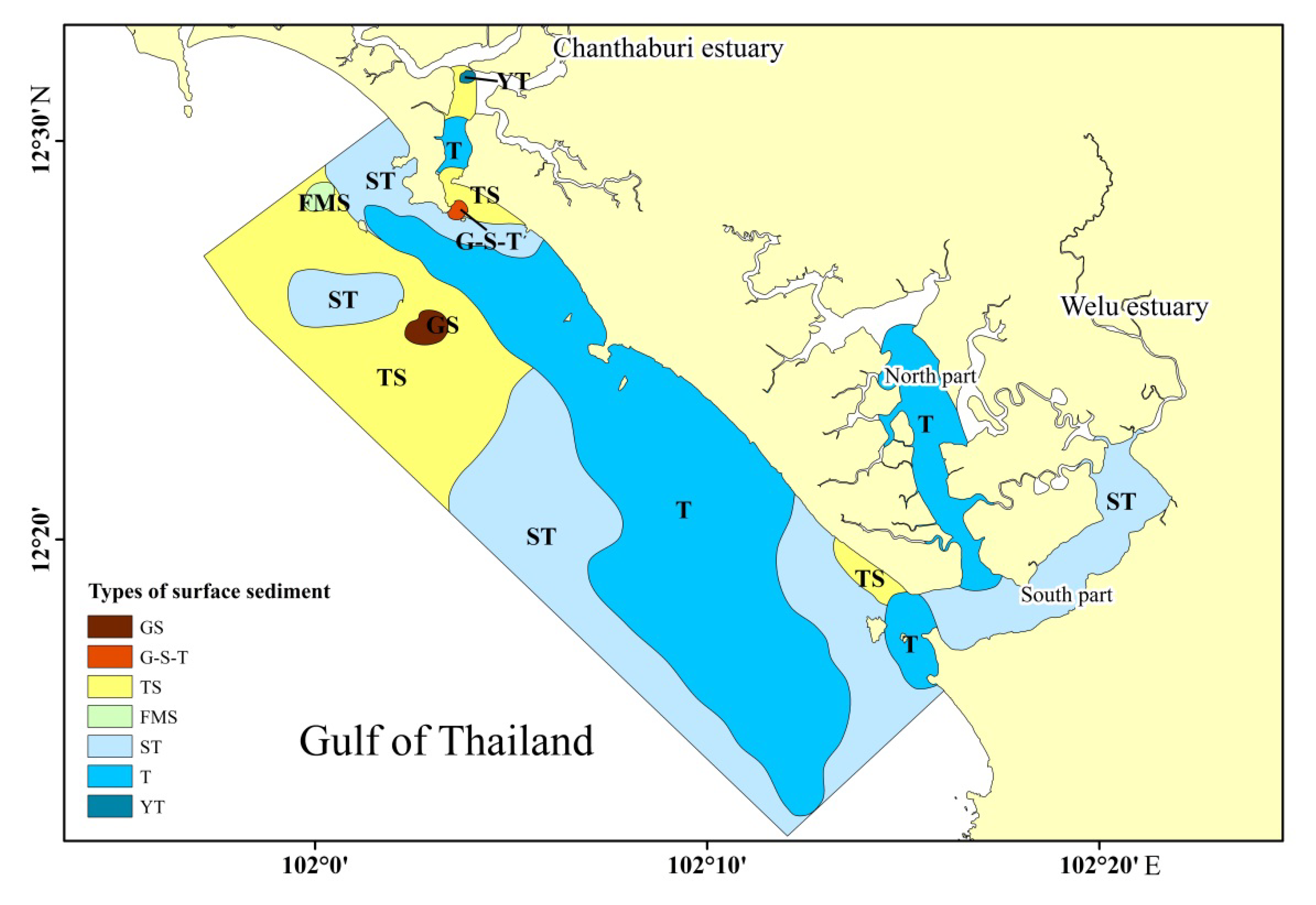
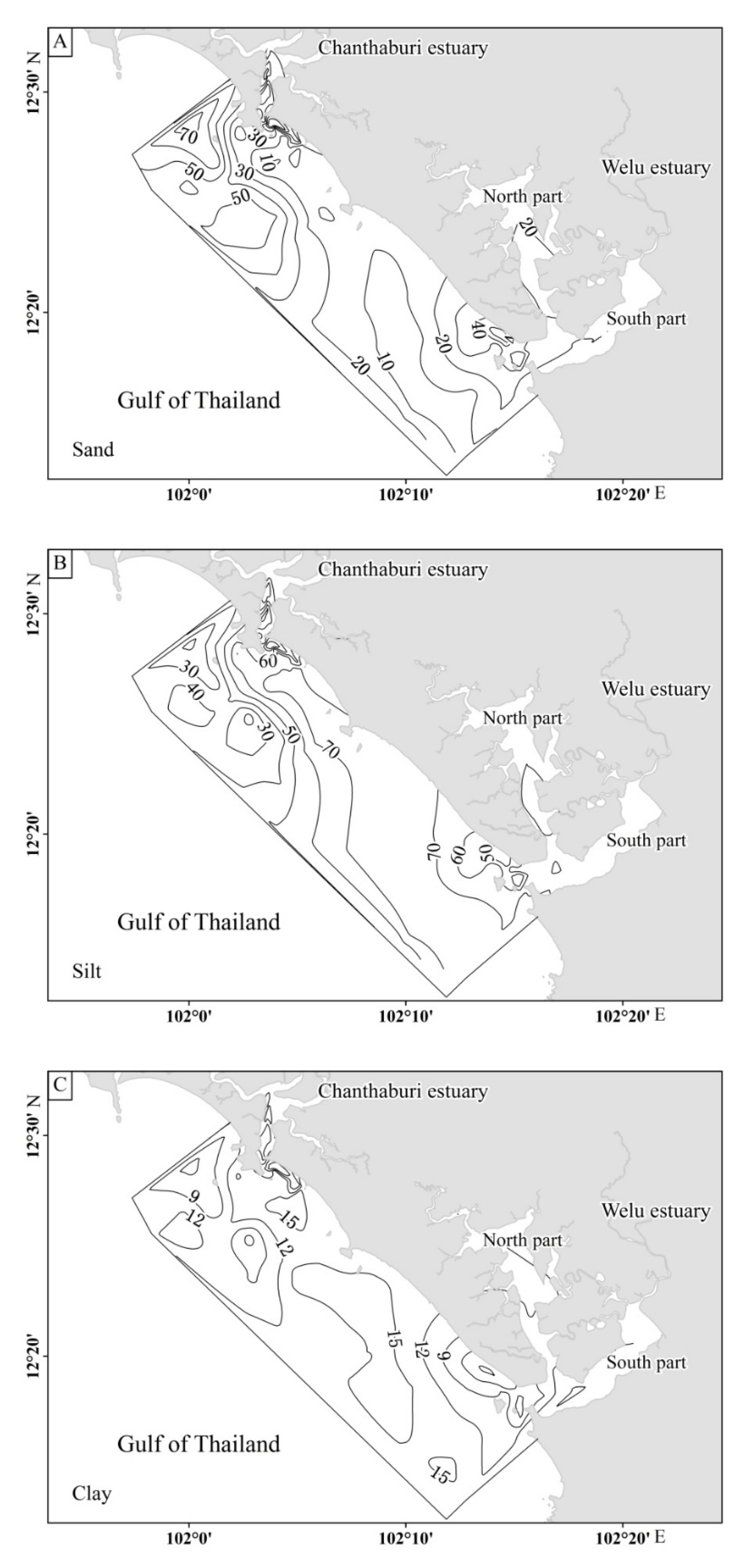

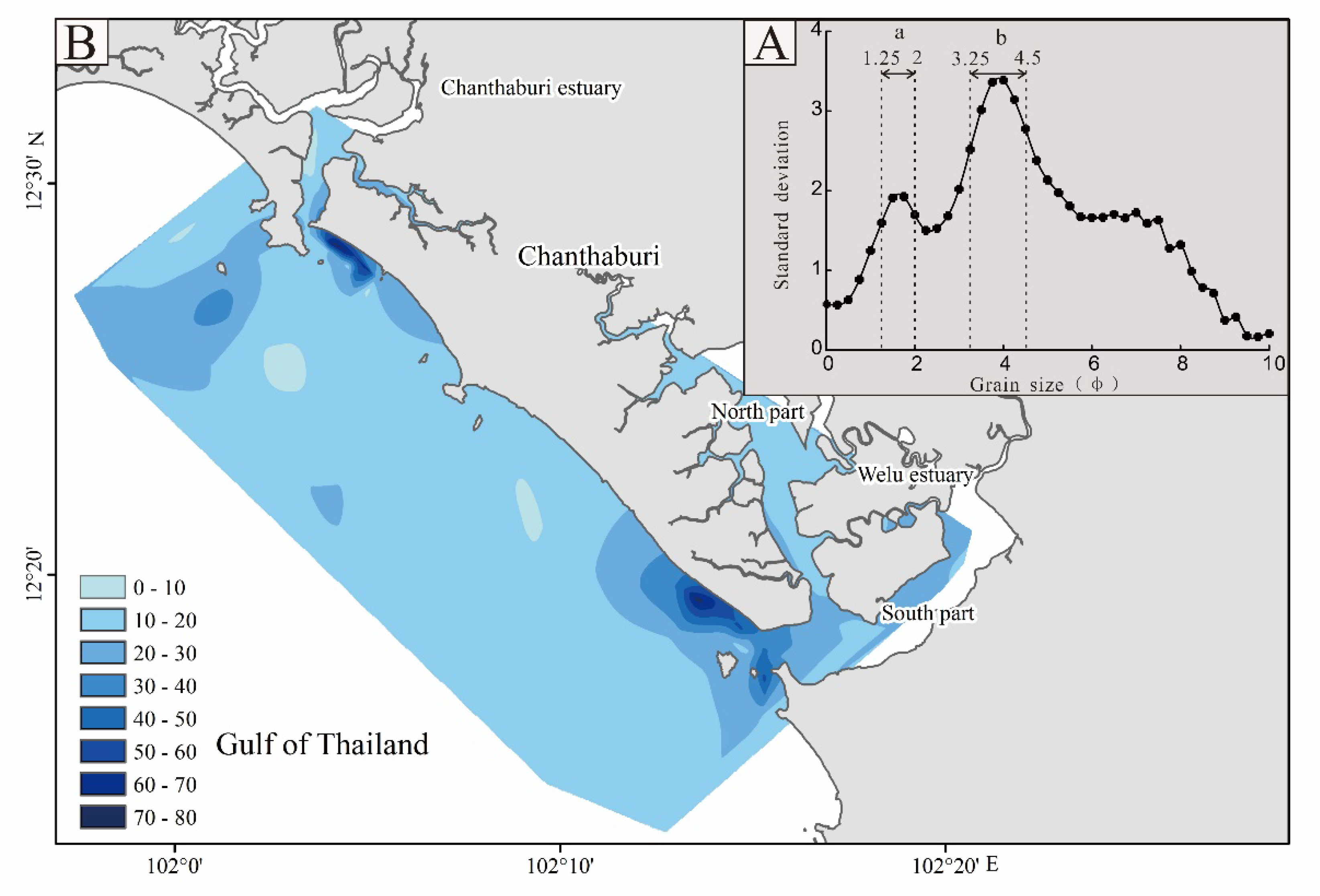
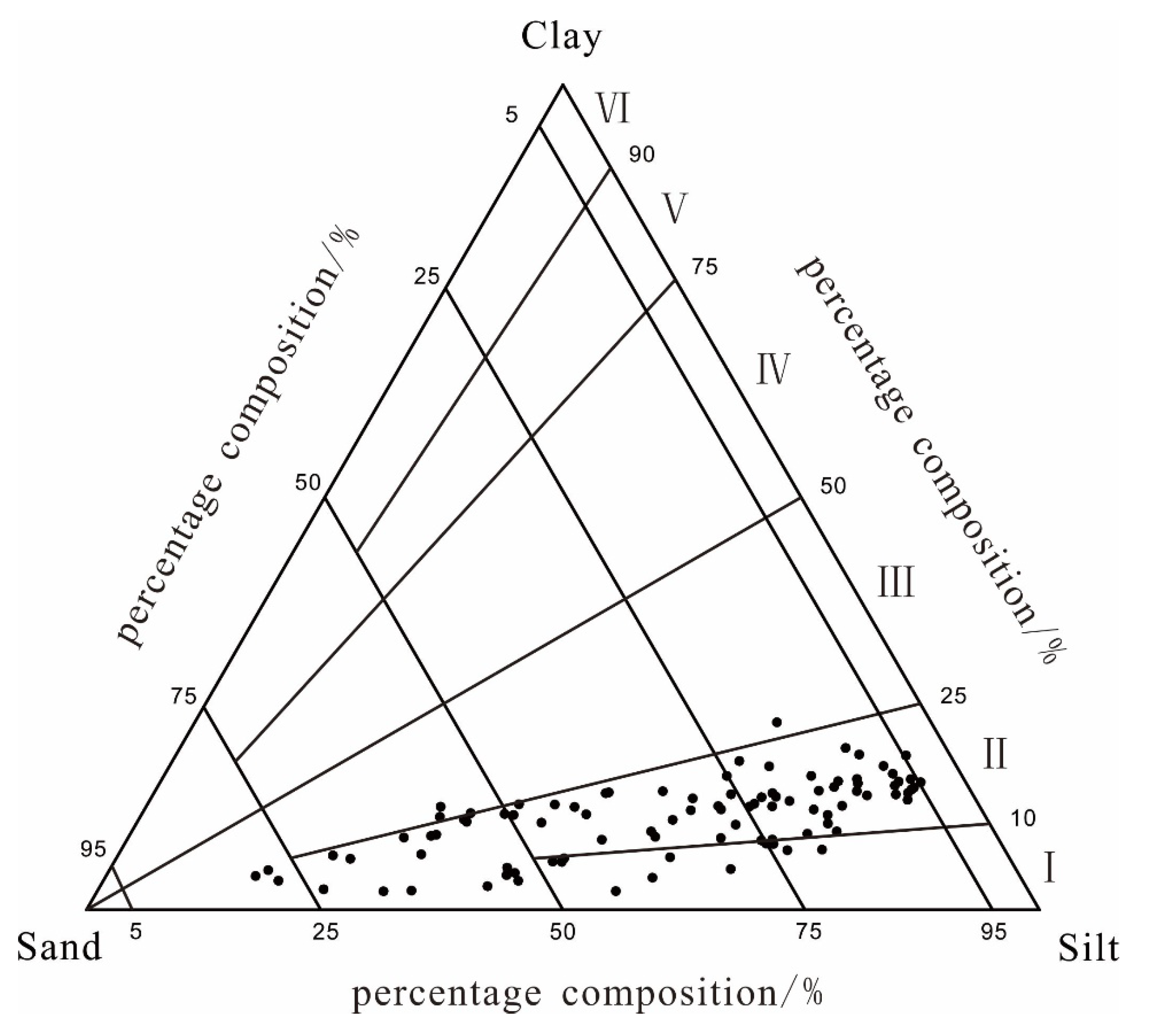
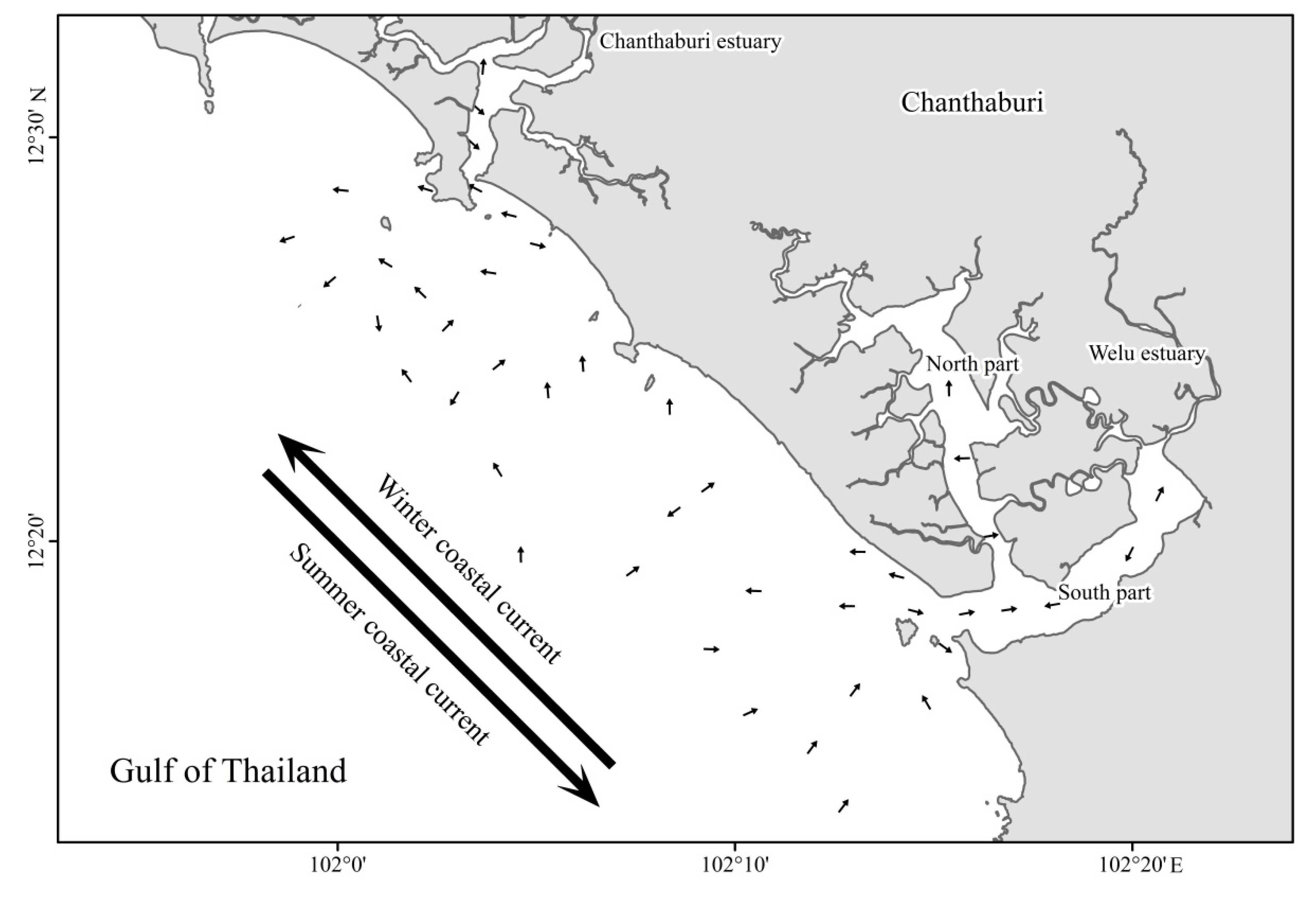
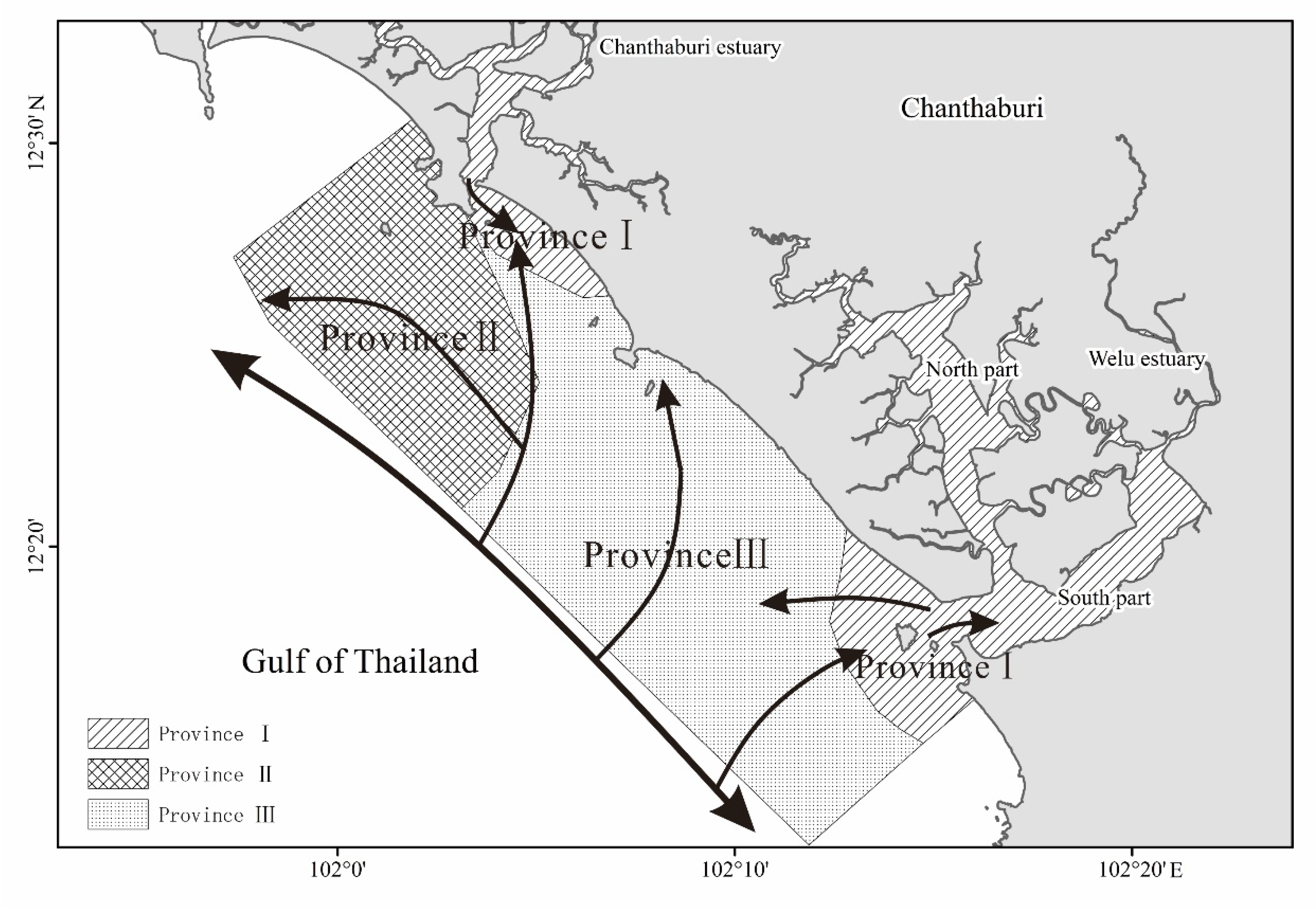
| River | Climate Zone | Nation | Tidal Range (m) | Suspended Sediment Concentration (kg/m3) | Runoff (m3/Year) |
|---|---|---|---|---|---|
| Chanthaburi | Tropical | Thailand | 0.8–1.2 | 0.023 | - |
| Welu | Tropical | Thailand | 0.8–1.2 | 0.016 | - |
| Oujiang [38,39] | Temperate | China | >4 | 0.131 | 469.1 × 108 |
| Jiulongjiang [40,41] | Temperate | China | 4 | 0.21–0.23 | 148.05 × 108 |
| The Pearl River [42,43,44] | Temperate | China | 1–1.7 | 0.1–0.3 | 1741 × 108 |
© 2020 by the authors. Licensee MDPI, Basel, Switzerland. This article is an open access article distributed under the terms and conditions of the Creative Commons Attribution (CC BY) license (http://creativecommons.org/licenses/by/4.0/).
Share and Cite
Wang, C.; Chen, M.; Qi, H.; Intasen, W.; Kanchanapant, A. Grain-Size Distribution of Surface Sediments in the Chanthaburi Coast, Thailand and Implications for the Sedimentary Dynamic Environment. J. Mar. Sci. Eng. 2020, 8, 242. https://doi.org/10.3390/jmse8040242
Wang C, Chen M, Qi H, Intasen W, Kanchanapant A. Grain-Size Distribution of Surface Sediments in the Chanthaburi Coast, Thailand and Implications for the Sedimentary Dynamic Environment. Journal of Marine Science and Engineering. 2020; 8(4):242. https://doi.org/10.3390/jmse8040242
Chicago/Turabian StyleWang, Chengtao, Min Chen, Hongshuai Qi, Wichien Intasen, and Apichai Kanchanapant. 2020. "Grain-Size Distribution of Surface Sediments in the Chanthaburi Coast, Thailand and Implications for the Sedimentary Dynamic Environment" Journal of Marine Science and Engineering 8, no. 4: 242. https://doi.org/10.3390/jmse8040242
APA StyleWang, C., Chen, M., Qi, H., Intasen, W., & Kanchanapant, A. (2020). Grain-Size Distribution of Surface Sediments in the Chanthaburi Coast, Thailand and Implications for the Sedimentary Dynamic Environment. Journal of Marine Science and Engineering, 8(4), 242. https://doi.org/10.3390/jmse8040242





